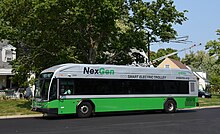|
Greater Dayton Regional Transit Authority
The Greater Dayton Regional Transit Authority, formerly known as the Miami Valley RTA, is a public transit agency that generally serves the greater Dayton, Ohio area. The GDRTA serves communities within Montgomery County and parts of Greene County, Ohio, USA. There are 18 routes. RTA operates diesel and electric trolley buses seven days a week, 21 hours a day, and provides services to many citizens within the area. RTA's current CEO is Bob Ruzinsky.[3] In 2023, the system had a ridership of 6,570,600, or about 24,700 per weekday as of the third quarter of 2024. Greater Dayton RTA is Ohio’s fourth-largest public transit system,[4] serving Dayton and 23 surrounding communities in Montgomery County and parts of Greene County. History
 The Miami Valley Regional Transit Authority (now the Greater Dayton Regional Transit Authority, or RTA) took over public transit operations in November 1972. In 2003, its board of trustees voted to change the transit agency's name to the Greater Dayton Regional Transit Authority.[5] Trolley buses One notable feature of the GDRTA system is its use of electric trolley buses. Only five cities in the United States currently have electric trolley buses: Boston, Dayton, Philadelphia, San Francisco and Seattle.[6] The first electric trolley bus (ETB) operation in Ohio occurred in Dayton, on April 23, 1933, when the Linden–Salem line was converted from streetcars to trackless trolleys — or trolley buses, as they are most commonly known today. The RTA renewed its commitment to electric transit with a board of trustees vote to continue the trolley bus service in 1991, and the purchase of a new fleet of ETBs from Electric Transit, Inc., a joint venture of the Czech company Skoda and the U.S. company AAI Corporation, based on Skoda's model 14Tr. Final assembly of the vehicles took place in Dayton in 1995–98. In 2014, the system added its first low-floor trolley buses, with four dual-mode prototypes purchased from Vossloh Kiepe (now Kiepe Electric) and using bodies from Gillig, for testing and evaluation. In January 2018, RTA placed an order with Kiepe for 26 production-series dual-mode trolleybuses of the same design as the prototypes, with Gillig low-floor bodies, for delivery starting in 2019.[7]  Electric streetcar service in Dayton had started in 1888, and it continued through to, and indeed beyond, the start of the trolley bus service. Therefore, electric transit service has been operated continuously in Dayton since 1888, which is longer than in any other city in the United States.[6] Hybrid buses With the addition of environmentally friendly hybrid buses in 2010 to the GDRTA's fleet, the GDRTA is Ohio's greenest transit fleet.[8][failed verification] In September 2010 RTA was designated the only 5-star Ohio Green Fleet by Clean Fuels Ohio. Hubs The RTA operates five bus "hubs", or transit centers. Each hub serves as a connection to many suburban bus routes around Dayton. The one in downtown Dayton is named Wright Stop Plaza and opened for service on September 1, 2009 (after a ceremonial opening earlier).[9][10] OperationThe RTA operates with diesel and electric trolley buses. Dayton is the smallest city in the United States to operate electric trolley buses still.[6] The trolley buses travel at least five miles on RTA routes serving Dayton and some neighboring suburbs. The routes include: Route 1, Route 2, Route 4, Route 7 and Route 8. Bus service to Dayton International Airport from downtown Dayton began on 11 August 2013. Service was expanded to stops on Pentagon Boulevard in Beavercreek, allowing access to the Fairfield Commons Mall and Soin Medical Center, on January 12, 2014. ContributionsThe RTA has been involved in helping the city of Dayton through its contributions to the Dayton Dragons, The Schuster Center, and the Dayton Aviation Heritage National Historical Park. In addition, RTA passed a resolution to make smoother connections to its regional hubs and prevent misuse of transfers. In January 2007, RTA created an established proposal to make all buses serve regional businesses, establish transfer points in designated areas and streamline previously neighborhood routes. The RTA added two routes to serve areas frequently used by passengers. RTA discontinued eight routes in response to overlapping and low passenger counts. Regular route list
Active Bus Fleet
See alsoReferences
External linksWikimedia Commons has media related to Greater Dayton Regional Transit Authority. |
|||||||||||||||||||||||||||||||||||||||||||||||||||||||||||||||||||||||||||||||||||||||||||||||||||||||||||||||||||||||||||
